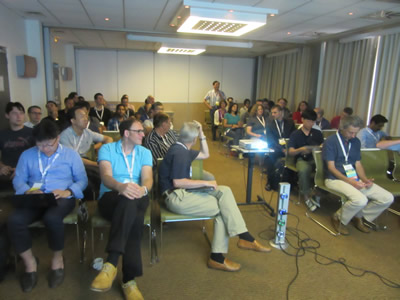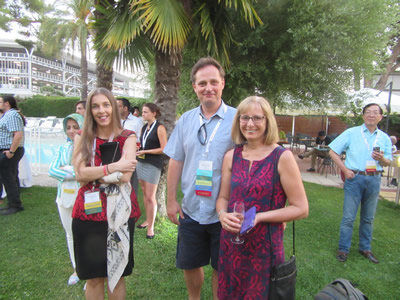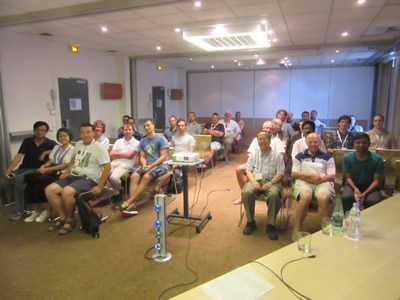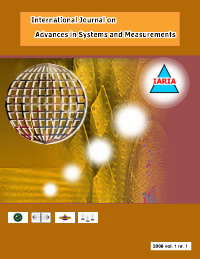PREDICTION SOLUTIONS 2022 - International Conference on Prediction Solutions for Technical and Societal Systems
July 24, 2022 - July 28, 2022
PREDICTION SOLUTIONS 2022: Call for Papers
Onsite and Online Options: In order to accommodate a large number of situations, we are offering the option for either physical presence or virtual participation (pdf slides or pre-recorded videos).
Organization predictions, market predictions, weather predictions, automation predictions, or ultimately, Garner curve technical predictions, constitute mechanisms and fundamental driving (future evaluation) methodologies for society’s industrial, investment, and customer behavioral expectations.
Generally, the prediction is concerned with estimating the outcomes for unseen data (rather than document observations); a sub-discipline considering time series data is the forecast, where the temporal dimension is shorter. Predictive processes are based on historical data combined with statistical modeling, data mining techniques, and machine learning. Prediction is leveraging data and patterns that are continuously gathered by forming datasets, using simulated samples, and statistics techniques.
The process starts with sensing data, identifying situations, and changes of different situational parameters. Via correlation functions and hypothesis, a variation of an input metric under observation triggers a set of metrics along with quantitative/qualitative characterizations (what? how much? when, for how long? etc.).
Most of the technical decisions in transportation systems based on long terms traffic patterns, QoS delivery and SLA satisfaction in wireless and ubiquitous systems (based on QoE ) or progresses in adopting 5G/6G and Industry 4.0/5.0) are based on an ensemble of successful technical factors, successful service delivery, and lessons learned. However, further development is linked to collecting data, applying mechanisms, predicting, testing, and confirming the perceived tendency.
Complex domains, dynamics changes, and entangled metrics relations make some events difficult to predict, with a large range of impreciseness. Generally, predictions are based on observable (sensed) metrics of a phenomenon in a given context, without considering internal variables/parameters of the phenomenon.
For forecasts (shorter terms predictions), the precision is critical (eventually concluding with an estimated probability). For hurricanes, the prediction of landing location is critical. Therefore, internal parameters are considered. For very short terms, forecasting is only partially possible, and dynamics that change suddenly leave no time to process unpredictable details (tornadoes).
Recursive predictions might be triggered by repetitive patterns, which are observed occurrences of a series of predictions with high score, eventually being endorsed as (pseudo-)laws. The most famous is the so-called “Murphy’s Law”.
PREDICTION SOLUTIONS event series is concerned with prediction facets in various technical, societal, and sense-based observations by gathering information, identify patterns, and defining (future) system requirements. The output of prediction is a set of critical factors used to evaluate systems’ characteristics qualitatively and quantitatively, as well as forecast the service demand directions. Prediction provides input on scalability, resilience, resource allocation, etc. and provides guidelines for future decisions.
We solicit both academic, research, and industrial contributions. We welcome technical papers presenting research and practical results, position papers addressing the pros and cons of specific proposals, such as those being discussed in the standard fora or in industry consortia, survey papers addressing the key problems and solutions on any of the above topics short papers on work in progress, and panel proposals.
Industrial presentations are not subject to the format and content constraints of regular submissions. We expect short and long presentations that express industrial position and status.
Tutorials on specific related topics and panels on challenging areas are encouraged.
The topics suggested by the conference can be discussed in term of concepts, state of the art, research, standards, implementations, running experiments, applications, and industrial case studies. Authors are invited to submit complete unpublished papers, which are not under review in any other conference or journal in the following, but not limited to, topic areas.
All topics and submission formats are open to both research and industry contributions.
PREDICTION SOLUTIONS 2022 conference themes:
Prediction fundamentals
Prediction process (observing, inferring, and classifying); Brain/Psycho predictions in social systems; Prediction techniques (rule-based predication, heuristic, fuzzy logic, etc.); Prediction statistical techniques (regression, bootstrapping, etc.); Agile prediction; Causality vs. Correlation relation; Negative predictive value, Sensitivity, Specificity; Formalizing brain psychological capabilities for prediction
New prediction modeling approaches
Modeling methodologies for repetitive predictions; Criteria for selecting a correlation type; Criteria for selecting a predictor variable for regression analyses; Predictor-based model discrimination and calibration; Experiments for building strong correlation functions; New combinations of correlation measurements; New correction matrix; Optimized correlations for a higher predictive power score; Detecting symmetric and asymmetric correlations; Identifying linear and non-linear correlations; Methods for detecting hidden patterns
Approaches for correlation functions and data
Solutions for correlating variables; Correlation functions with continuous and discrete variables; Guidelines for selection of correlation indicator; Modeling the data with parametric and non-parametric predictive models; Datasets and Machine Learning; Correlation functions for multimodal Big Data; Correlation through AI-based recursive forecasting; Incorporate external intelligence and/or extraneous variables; Private prediction (private ML-based scenarios, public output); Scale-up and scale-down prediction accuracy
Methods/tools for prediction testing and validation
Simulation via Digital Twins technology; Predictive testing tools; Parametric tests (means) and non-parametric tests (medians); Testing recursive predictions; Hypothesis tests: parametric tests (means) and non-parametric tests (medians); Guidelines for test selection vs data distribution
Solutions for prevention via prediction
Preventing systems failures (fault-tolerant systems, resilience, etc.); Preventing thefts (humankind, cyber-protection, etc.); Preventing social crimes (hot spot predictions, etc.); Prevent technical disruptions (predictions on supply chains, intermittent medical assistance, etc.); Prevent massive service disruptions (predictive Internet, power failure, etc.); Solutions for preventive safety (transportations, food industry, hazards, thefts, etc.); General outcome for outturns of any predictions
Solutions and challenges for trending technologies
Solutions for predictive maintenance; Solutions on predictive Internet; Predictive success on restorative medicine; Predictive solutions on mobile health technology in brain-related illnesses; Predictions on massive Cloud-based technology adoptions; Predictions on service availability of hybrid Cloud and Edge/For computing; Case of predicting penetration rate of intelligent automation (Industry 4/0/5.0); Prediction on privacy invasion in human-centered devices/services; Predictions on Return on Investment (RoI) for Blockchain and 5G; Prediction of adoption of Virtual Reality and Augmented Reality; Predictive trust in system resiliency; AI-based prediction of cyber-attacks
Applications in selected domains
Financial markets predictions (inflation, crash, boom, etc.); Predictions in real estate market (home prices, sale volumes, etc.); Prediction model in media consumption (audience, specific media, etc.); Spatial/localization prediction (any domain; see volcano vs fault lines); Natural disasters/catastrophes (forecast based on atmospheric observations); Earthquake predictions models; Predict/Forecast for climate changes (drought, rain, temperature, pollution, etc.); Predict/Forecast local/nationwide of emergency events occurrence (wildfire, flooding, travel conditions); Epidemic/Pandemic prediction models (spreading areas, contagiousness, virulence, etc.); Social predictions (political races, education, etc.)
Models, solutions, applications, and lessons learned
Archaeology; Astronomy; Biology; Economics; Education; Marketing; Medicine and Health Care; Musicology; Psychology; Risk Management; Social Sciences
Deadlines:
Submission | May 22, 2022 |
Notification | Jun 15, 2022 |
Registration | Jun 22, 2022 |
Camera ready | Jun 25, 2022 |
Deadlines differ for special tracks. Please consult the conference home page for special tracks Call for Papers (if any).
INSTRUCTION FOR THE AUTHORS
Authors of selected papers will be invited to submit extended versions to one of the IARIA Journals.
Publisher: XPS (Xpert Publishing Services)
Archived: ThinkMindTM Digital Library (free access)
Prints available at Curran Associates, Inc.
How to submit to appropriate indexes.
Only .pdf or .doc files will be accepted for paper submission. All received submissions will be acknowledged via an automated system.
Contribution types
- regular papers [in the proceedings, digital library]
- short papers (work in progress) [in the proceedings, digital library]
- ideas: two pages [in the proceedings, digital library]
- extended abstracts: two pages [in the proceedings, digital library]
- posters: two pages [in the proceedings, digital library]
- posters: slide only [slide-deck posted on www.iaria.org]
- presentations: slide only [slide-deck posted on www.iaria.org]
- demos: two pages [posted on www.iaria.org]
FORMATS
Only .pdf or .doc files will be accepted for paper submission. All received submissions will be acknowledged via an automated system.
Final author manuscripts will be 8.5" x 11", not exceeding 6 pages; max 4 extra pages allowed at additional cost.
Helpful information for paper formatting for MS Word can be found here.
There is a community provided LaTeX template: the CTAN package iaria (with full IARIA formatting rules, including IARIA citation style, but for providing citation style it is tightly bound to pdflatex+biblatex+biber). In addition, there is also iaria-lite (not bound to pdflatex+biblatex+biber, but compatible with any TeX stack; thus, it cannot provide the IARIA citation formattings, but only the titlepage and content-related IARIA formatting rules). Based on the iaria package, there is a minimal working example as Overleaf template. When you are using the LaTeX templates, please still adhere to the additional editorial rules.
Slides-based contributions can use the corporate/university format and style.
Your paper should also comply with the additional editorial rules.
Once you receive the notification of contribution acceptance, you will be provided by the publisher an online author kit with all the steps an author needs to follow to submit the final version. The author kits URL will be included in the letter of acceptance.
We would recommend that you should not use too many extra pages, even if you can afford the extra fees. No more than 2 contributions per event are recommended, as each contribution must be separately registered and paid for. At least one author of each accepted paper must register to ensure that the paper will be included in the conference proceedings and in the digital library, or posted on the www.iaria.org (for slide-based contributions).
CONTRIBUTION TYPE
Regular Papers (up to 6-10 page article -6 pages covered the by regular registration; max 4 extra pages allowed at additional cost- ) (oral presentation)
These contributions could be academic or industrial research, survey, white, implementation-oriented, architecture-oriented, white papers, etc. They will be included in the proceedings, posted in the free-access ThinkMind digital library and sent for indexing. Please submit the contributions following the instructions for the regular submissions using the "Submit a Paper" button and selecting the appropriate contribution type. 12-14 presentation slides are suggested.
Short papers (work in progress) (up to 4 pages long) (oral presentation)
Work-in-progress contributions are welcome. These contributions represent partial achievements of longer-term projects. They could be academic or industrial research, survey, white, implementation-oriented, architecture-oriented, white papers, etc. Please submit the contributions following the instructions for the regular submissions using the "Submit a Paper" button and selecting the contribution type as work in progress. Contributors must follow the conference deadlines, describing early research and novel skeleton ideas in the areas of the conference topics. The work will be published in the conference proceedings, posted in the free-access ThinkMind digital library and sent for indexing. For more details, see the Work in Progress explanation page. 12-14 presentation slides are suggested.
Ideas contributions (2 pages long) (oral presentation)
This category is dedicated to new ideas in their very early stage. Idea contributions are expression of yet to be developed approaches, with pros/cons, not yet consolidated. Ideas contributions are intended for a debate and audience feedback. Please submit the contributions following the instructions for the regular submissions using the "Submit a Paper" button and selecting the contribution type as Idea. Contributors must follow the conference deadlines, describing early research and novel skeleton ideas in the areas of the conference topics. The work will be published in the conference proceedings, posted in the free-access ThinkMind digital library and sent for indexing. For more details, see the Ideas explanation page. 12-14 presentation slides are suggested.
Extended abstracts (2 pages long) (oral presentation)
Extended abstracts summarize a long potential publication with noticeable results. It is intended for sharing yet to be written, or further on intended for a journal publication. Please submit the contributions following the instructions for the regular submissions using the "Submit a Paper" button and selecting the contribution type as Extended abstract. Contributors must follow the conference deadlines, describing early research and novel skeleton ideas in the areas of the conference topics. The work will be published in the conference proceedings, posted in the free-access ThinkMind digital library and sent for indexing. 12-14 presentation slides are suggested.
Posters (paper-based, two pages long) (oral presentation)
Posters are intended for ongoing research projects, concrete realizations, or industrial applications/projects presentations. The poster may be presented during sessions reserved for posters, or mixed with presentation of articles of similar topic. A two-page paper summarizes a presentation intended to be a POSTER. This allows an author to summarize a series of results and expose them via a big number of figures, graphics and tables. Please submit the contributions following the instructions for the regular submissions using the "Submit a Paper" button and selecting the contribution type as Poster Two Pages. Contributors must follow the conference deadlines, describing early research and novel skeleton ideas in the areas of the conference topics. The work will be published in the conference proceedings, posted in the free-access ThinkMind digital library and sent for indexing. 8-10 presentation slides are suggested. Also a big Poster is suitable, used for live discussions with the attendees, in addition to the oral presentation.
Posters (slide-based, only) (oral presentation)
Posters are intended for ongoing research projects, concrete realizations, or industrial applications/projects presentations. The poster may be presented during sessions reserved for posters, or mixed with presentation of articles of similar topic. The slides must have comprehensive comments. This type of contribution only requires a 8-10 slide-deck. Please submit the contributions following the instructions for the regular submissions using the "Submit a Paper" button and selecting the contribution type as Poster (slide-only). The slide-deck will be posted, post-event, on www.iaria.org.
8-10 presentation slides are suggested. Also a big Poster is suitable, used for live discussions with the attendees, additionally to the oral presentation.
Presentations (slide-based, only) (oral presentation)
These contributions represent technical marketing/industrial/business/positioning presentations. This type of contribution only requires a 12-14 slide-deck. Please submit the contributions following the submission instructions by using the "Submit a Paper" button and selecting the contribution type as Presentation (slide-only). The slide-deck will be posted, post-event, on www.iaria.org.
12-14 presentation slides are suggested.
Demos (two pages) [posted on www.iaria.org]
Demos represent special contributions where a tool, an implementation of an application, or a freshly implemented system is presented in its alfa/beta version. It might also be intended for thsoe new application to gather the attendee opinion. A two-page summary for a demo is intended to be. It would be scheduled in special time spots, to ensure a maximum attendance from the participants. Please submit the contributions following the submission instructions by using the "Submit a Paper" button and selecting the contribution type as Demos. The Demos paper will be posted, post-event, on www.iaria.org.
Tutorial proposals
Tutorials provide overviews of current high interest topics. Proposals should be for 2-3 hour long. Proposals must contain the title, the summary of the content, and the biography of the presenter(s). The tutorial slide decks will be posted on the IARIA site.
Please send your proposals to tutorial proposal
Panel proposals
The organizers encourage scientists and industry leaders to organize dedicated panels dealing with controversial and challenging topics and paradigms. Panel moderators are asked to identify their guests and manage that their appropriate talk supports timely reach our deadlines. Moderators must specifically submit an official proposal, indicating their background, panelist names, their affiliation, the topic of the panel, as well as short biographies. The panel slide deck will be posted on the IARIA site.
Please send your proposals to panel proposal








































































